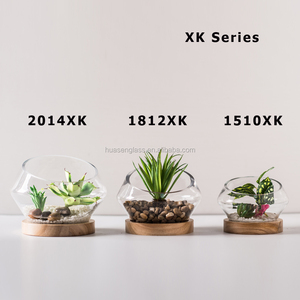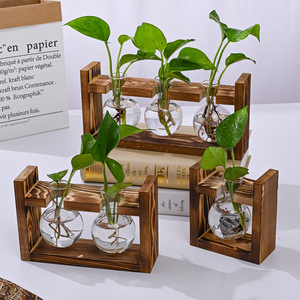(1116 products available)








































 Ready to Ship
Ready to Ship















































































































































































Small terrarium plants are tiny plants that are grown in small glass containers called terrariums. These plants thrive in the enclosed environment of a terrarium, where humidity levels are higher, and the plants receive the moisture they require. They are easy to maintain and add a touch of greenery to any indoor space. Some common types of great terrarium plants are:
Designing a small terrarium garden is a fun and challenging process. It's about balancing the needs of plants and aesthetics. Terrariums can be designed in many ways, from sleek and modern to wild and natural. Some important design aspects to consider are as follows:
Different terrarium themes can be created. So, decide on a look that fits the space and personal style. A minimalist terrarium has only a few carefully chosen elements. A fairy garden terrarium is whimsical, with tiny figurines and colorful stones. A desert terrarium is dry, with cacti and sand. Sticking to a theme makes the design cohesive and pleasing to the eye.
Containers come in many shapes, like fishbowls, geometric glass, or old jars. Choose one that complements the theme. Traditional terrariums use glass containers. Open containers let in more air, good for plants that don't like humidity.
Choose small terrarium plants that are small and thrive in the environment. Cacti and succulents like dry terrariums. Ferns and moss prefer humid ones. Consider plants' care needs, like light and water. Remember to provide a good drainage layer at the bottom of the container.
Arrange plants to create visual interest. Use odd numbers and vary plant heights. Place taller plants in the back and shorter ones in the front. Balance colors and textures. Light leaves can offset dark ones, and smooth rocks can complement feathery ferns.
Decorate the terrarium with accessories. Small figurines, colored sand, and tiny rocks can add interest. But don't go overboard; less is often more. Natural elements like driftwood and stones can be nice touches.
Consider where to put the terrarium for proper care. Most plants need some sunlight each day. But too much can bake them in a container. Place the terrarium near a window but out of direct sun. LED grow lights can help if sunlight is limited. LED lights don't get hot and come in many sizes.
Small terrarium plants can be used in many scenarios. These are some of the main ones:
Small terrarium plants can be displayed in garden centers or plant shops. They can show customers the plants and the types of containers that can be used. The display will inspire people to make their terrariums. The plants should be kept in good condition for the customers to see. The display will attract customers and help with plant sales. The plants should be of different sizes and shapes to suit different terrariums. The display should be well-maintained to create a good impression.
People can give a small terrarium plant as a favor at events. The plant can be a nice gift that guests will remember for a long time. The plants are placed in small containers with event information. The plants can be given at weddings, parties, or corporate events. The plants can be a unique and environmentally friendly gift. They can also be customized to match the event theme. They will make the event memorable for the guests.
Small terrarium plants are a good option for decorating office desks. They do not need much care, making them suitable for office settings. They can enhance the look of the desk and make the office more appealing. They can also improve air quality, making the work environment healthier. They can be kept in glass containers to give the desk a modern look. They will bring a touch of nature to the office. They can create a calm and productive work environment.
Small terrarium plants can be used in educational projects for children. They can help students learn about plant growth and ecosystems. The plants can be used to create simple terrariums in containers that are easy for children to use. They will help children understand how plants grow, the water cycle, and the importance of taking care of the environment. The projects will be fun and educational. They will help the children appreciate nature.
Restaurants can use small terrarium plants to decorate tables. The plants can help create a pleasant dining atmosphere. They can enhance the dining experience for customers. They can make the dining area more attractive and comfortable. They can also purify the air and create fresh air for customers. The plants are easy to care for and do not take up much space. They can be placed in the center of the table or at the edges. They will create a natural and fresh atmosphere for diners.
For a successful terrarium, selecting the right plants is crucial. Some of the things to consider when choosing small terrarium plants are:
Q1: How often should one water a small terrarium plant?
A1: The watering needs of terrarium plants vary. Some plants require more frequent watering to mimic their natural, moist habitat, while others, like succulents and cacti, do not need as much water. It's crucial to monitor the soil's moisture level. The soil should be slightly damp but not saturated for plants that require more water. For those that don't need regular watering, ensure that the soil is dry between waterings.
Q2: How should one fertilize small terrarium plants?
A2: Fertilizing should be done sparingly to avoid a build-up of nutrients that can harm the small plants. Utilize a diluted, balanced fertilizer during the growing season. Fertilize even less or not at all during the dormant season, depending on the plant. Over-fertilizing can lead to leggy growth, browning of the leaves, or even plant death. If the soil has been used for a long time, it may need to be changed or refreshed. Clear the soil and replace it with fresh, fertile soil to provide the plants with a nutrient boost.
Q3: What should be done if a plant outgrows its terrarium?
A3: If a plant outgrows its container, it is best to remove it and replant it. To do this, carefully remove the plant, gently loosen the root ball, and replant it in a bigger container with new soil appropriate for the plant's needs. Ensure the new container has excellent drainage and consider adjusting the terrarium's design to accommodate the newly added space.